Pronghorn
The pronghorn (UK: /ˈprɒŋhɔːrn/, US: /ˈprɔːŋ-/)[3] (Antilocapra americana) is a species of artiodactyl (even-toed, hoofed) mammal indigenous to interior western and central North America. Though not an antelope, it is often known colloquially in North America as the American antelope, prong buck, pronghorn antelope, prairie antelope, or simply antelope[4] because it closely resembles the true antelopes of the Old World and fills a similar ecological niche due to parallel evolution.[5] It is the only surviving member of the family Antilocapridae.[6]
| Pronghorn | |
|---|---|
 | |
| Adult male pronghorn in Oregon | |
.jpg) | |
| Adult female pronghorn in Wyoming | |
| Scientific classification | |
| Kingdom: | Animalia |
| Phylum: | Chordata |
| Class: | Mammalia |
| Order: | Artiodactyla |
| Family: | Antilocapridae |
| Subfamily: | Antilocaprinae |
| Tribe: | Antilocaprini |
| Genus: | Antilocapra Ord, 1818 |
| Species: | A. americana[2] |
| Binomial name | |
| Antilocapra americana[2] (Ord, 1815) | |
| Subspecies | |
|
A. a. americana | |
 | |
| Range of the Pronghorn | |
During the Pleistocene epoch, about 12 antilocaprid species existed in North America.[7] Three other genera (Capromeryx,[8][9] Stockoceros[10][11] and Tetrameryx[12]) existed when humans entered North America but are now extinct.
As a member of the superfamily Giraffoidea, the pronghorn's closest living relatives are the giraffes and okapi. The Giraffoidea are in turn members of the infraorder Pecora, making pronghorns more distant relatives of the Cervidae (deer) and Bovidae (cattle, goats, sheep, antelopes, and gazelles), among others.
The pronghorn is the symbol of the American Society of Mammalogists.[13]
Discovery and taxonomy
Prior to the arrival of the Europeans, the pronghorn was particularly abundant in the region of the Plains Indians and the region of the indigenous people of the Northwest Plateau and was hunted as a principal food source by the local tribes.[14] The antelope has also featured prominently in Native American mythology and oral history.[15]
The scientific name of the pronghorn is Antilocapra americana. Although first seen and described by Spanish explorers in the 16th century, the species was not formally recorded or scrutinized until the 1804–1806 expedition by Captain Meriwether Lewis and Second Lieutenant William Clark.[16] Following the discovery of a few subspecies of the sharp-tailed grouse, Lewis and Clark came across the pronghorn near the mouth of the Niobrara River, in present-day Nebraska. Clark was the first European to kill a pronghorn, and described his experience as follows:[17]
I walked on shore to find an old Vulcanoe [the Ionia Volcano?] ... in my walk I killed a Buck Goat of this Countrey, about the height of the Grown Deer, its body Shorter the horns which is not very hard and forks 2⁄3 up one prong Short the other round & Sharp arched, and is immediately above its Eyes the Color is a light gray with black behind its ears down the neck, and its face white round its neck, its Sides and its rump round its tail which is Short & white; Verry actively made, has only a pair of hoofs to each foot, his brains on the back of his head, his Nostrals large, his eyes like a Sheep he is more like the Antilope or Gazelle of Africa than any other Species of Goat.
Lewis and Clark made several other observations on the behavior of the pronghorn and how the local tribes hunted them. They described the animal, which they referred to as the "Antelope" or the "Goat", as follows:[18]
Of all the animals we have seen the Antelope seems to possess the most wonderful fleetness. Shy and timorous they generally repose only on the ridges, which command a view of all the approaches of an enemy ... When they first see the hunters they run with great velocity ... The Indians near the Rocky Mountains hunt these animals on horseback, and shoot them with arrows. The Mandans' mode of hunting them is to form a large, strong pen or fold, from which a fence made of bushes gradually widens on each side. The animals are surrounded by the hunters, and gently driven towards this pen, in which they imperceptibly find themselves enclosed, and are then at the mercy of the hunters.
The pronghorn was first officially described by American ornithologist George Ord in 1815.[18]
Description
Pronghorns have distinct white fur on their rumps, sides, breasts, bellies, and across their throats. Adult males are 1.3–1.5 m (4 ft 3 in–4 ft 11 in) long from nose to tail, stand 81–104 cm (32–41 in) high at the shoulder, and weigh 40–65 kg (88–143 lb). The females are the same height as males, but weigh 34–48 kg (75–106 lb). The feet have two hooves, with no dewclaws. Their body temperature is 38 °C (100 °F).[7][19][20][21]

The orbits (eye sockets) are prominent and set high on the skull. Their teeth are hypsodont, and their dental formula is 0.0.3.33.1.3.3.
.jpg)
Each horn of the pronghorn is composed of a slender, laterally flattened blade of bone which is thought to grow from the frontal bones of the skull, or from the subcutaneous tissues of the scalp, forming a permanent core.[22] As in the Giraffidae, skin covers the bony cores, but in the pronghorn, it develops into a keratinous sheath which is shed and regrown annually. Unlike the horns of the family Bovidae, the horn sheaths of the pronghorn are branched, each sheath having a forward-pointing tine (hence the name pronghorn). Males have a horn sheath about 12.5–43 cm (4.9–16.9 in) (average 25 cm (9.8 in)) long with a prong. Females have smaller horns that range from 2.5–15.2 cm (1–6 in) (average 12 centimetres (4.7 in)) and sometimes barely visible; they are straight and very rarely pronged.[20] Males are further differentiated from females in having a small patch of black hair at the angle of the mandible. Pronghorns have a distinct, musky odor. Males mark territory with a preorbital scent gland which is on the sides of the head.[7] They also have very large eyes with a 320° field of vision. Unlike deer, pronghorns possess a gallbladder.[23]
The pronghorn is the fastest land mammal in the Western Hemisphere, being built for maximum predator evasion through running. The top speed is very hard to measure accurately and varies between individuals; it can run 35 mph for 4 mi (56 km/h for 6 km), 42 mph for 1 mi (67 km/h for 1.6 km), and 55 mph for 0.5 mi (88.5 km/h for 0.8 km).[19][24] While it is often cited as the second-fastest land animal, second only to the African cheetah,[25] it can sustain high speeds longer than cheetahs.[6] University of Idaho zoologist John Byers has suggested the pronghorn evolved its running ability to escape from now-extinct predators such as the American cheetah, since its speed greatly exceeds that of all extant North American predators.[6][26] Compared to its body size, the pronghorn has a large windpipe, heart, and lungs to allow it to take in large amounts of air when running. Additionally, pronghorn hooves have two long, cushioned, pointed toes which help absorb shock when running at high speeds.[27] They also have an extremely light bone structure and hollow hair.
Pronghorns are built for speed, not for jumping. Since their ranges are sometimes affected by sheep ranchers' fences, they can be seen going under fences, sometimes at high speed. For this reason, the Arizona Antelope Foundation and others are in the process of removing the bottom barbed wire from the fences, and/or installing a barbless bottom wire.[28]
The pronghorn has been observed to have at least 13 distinct gaits, including one reaching nearly 7.3 m (8.0 yd) per stride.[6]
Range and ecology
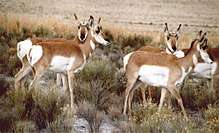
The present-day range of the pronghorn extends from southern Saskatchewan and Alberta in Canada south through the United States (southwestern Minnesota and central Texas west to coastal southern California)[29][30] and northern Baja California Sur, to Sonora and San Luis Potosí in northern Mexico.[7][31]
A subspecies known as the Sonoran pronghorn (A. a. sonoriensis) occurs in Arizona and Mexico.[20] Other subspecies include the Mexican pronghorn (A. a. mexicana), the Oregon pronghorn (A. a. oregona), and the critically endangered Baja California pronghorn (A. a. peninsularis).
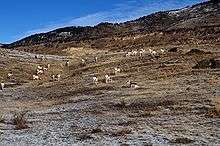
Pronghorns prefer open, expansive terrain at elevations varying between 900 and 1,800 m (3,000 and 5,900 ft), with the densest populations in areas receiving around 25–40 cm (9.8–15.7 in) of rainfall per year. They eat a wide variety of plant foods, often including plants unpalatable or toxic to domestic livestock, though they also compete with them for food.[19] In one study, forbs comprised 62% of their diet, shrubs 23%, and grasses 15%,[19] while in another, cacti comprised 40%, grass 22%, forbs 20%, and shrubs 18%.[20] Pronghorns also chew and eat (ruminate) cud.
Healthy pronghorn populations tend to stay within 5.0–6.5 km (3.1–4.0 mi) of a water source.
An ongoing study by the Lava Lake Institute for Science and Conservation and the Wildlife Conservation Society shows an overland migration route that covers more than 160 mi (260 km).[32] The migrating pronghorn start travel from the foothills of the Pioneer Mountains through Craters of the Moon National Monument to the Continental Divide. Dr. Scott Bergen of the Wildlife Conservation Society says "This study shows that pronghorn are the true marathoners of the American West. With these new findings, we can confirm that Idaho supports a major overland mammal migration - an increasingly rare phenomenon in the U.S. and worldwide."[33]
Cougars, wolves, coyotes, and bobcats are major predators of pronghorns. Golden eagles have been reported to prey on fawns and adults. Jaguars also likely prey on pronghorns in their native range in the southwestern United States and in northern Mexico.
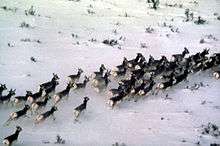
Social behavior and reproduction
Pronghorns form mixed-sex herds in the winter. In early spring, the herds break up, with young males forming bachelor groups, females forming harems, and adult males living solitarily.[34] Some female bands share the same summer range, and bachelor male bands form between spring and fall. Females form dominance hierarchies with few circular relationships.[35] Dominant females aggressively displace other females from feeding sites.
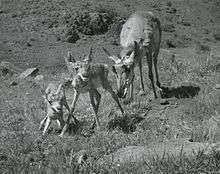
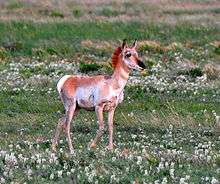
Adult males either defend a fixed territory that females may enter, or defend a harem of females. A pronghorn may change mating strategies depending on environmental or demographic conditions.[34] Where precipitation is high, adult males tend to be territorial and maintain their territories with scent marking, vocalizing, and challenging intruders.[36] In these systems, territorial males have access to better resources than bachelor males.[36] Females also employ different mating strategies. "Sampling" females visit several males and remain with each for a short time before switching to the next male at an increasing rate as estrous approaches. "Inciting" females behave as samplers until estrous, and then incite conflicts between males, watching and then mating with the winners.[37] Before fighting, males try to intimidate each other. If intimidation fails, they lock horns and try to injure each other.[20] "Quiet" females remain with a single male in an isolated area throughout estrous.[37] Females continue this mating behavior for two to three weeks.[20]
When courting an estrous female, a male pronghorn approaches her while softly vocalizing[38][34] and waving his head side to side, displaying his cheek patches.[39] The scent glands on the pronghorn are on either side of the jaw, between the hooves, and on the rump.[20] A receptive female remains motionless, sniffs his scent gland, and then allows the male to mount her.[34][40]
Pronghorns have a gestation period of 7–8 months, which is longer than is typical for North American ungulates. They breed in mid-September, and the doe carries her fawn until late May. The gestation period is around six weeks longer than that of the white-tailed deer. Females usually bear within a few days of each other.[19] Twin fawns are common.[27] Newborn pronghorns weigh 2–4 kg (4.4–8.8 lb), most commonly 3 kg (6.6 lb). In their first 21–26 days, fawns spend time hiding in vegetation.[36] Fawns interact with their mothers for 20–25 minutes a day; this continues even when the fawn joins a nursery.[36] The females nurse, groom, and lead their young to food and water, as well as keep predators away from them.[36] Females usually nurse the young about three times a day.[19] Males are weaned 2–3 weeks earlier than females.[36] Sexual maturity is reached at 15 to 16 months, though males rarely breed until three years old. Their lifespan is typically up to 10 years, rarely 15 years.[19][20][21]
Population and conservation
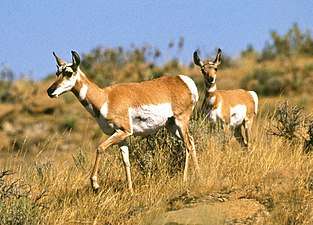
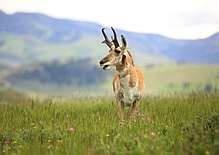
At the turn of the 20th century, members of the wildlife conservation group Boone and Crockett Club had determined that the extinction of the pronghorn was likely. In a letter from George Bird Grinnell, Boone and Crockett Club chairman of the game preservation committee, to Walter L. Fisher, Secretary of the Interior, Grinnell stated, "The Club is much concerned about the fate of the pronghorn which appears to be everywhere rapidly diminishing." By the 1920s, hunting pressure had reduced the pronghorn population to about 13,000.[6] Boone and Crockett Club member Charles Alexander Sheldon, in a letter to fellow member Grinnell, wrote, "Personally, I think that the antelope are doomed, yet every attempt should be made to save them." Although the Club had begun their efforts to save the pronghorn in 1910 by funding and restocking the Wichita Game Refuge in Oklahoma, the National Bison Range in Montana, and the Wind Cave National Park, in South Dakota, most of the efforts were doomed since experience demonstrated that after initial increases the pronghorns would die off because of the fenced enclosures. In 1927, Grinnell spearheaded efforts along with the help of T. Gilbert Pearson of Grinnell's National Audubon Society to create the Charles Alexander Sheldon Antelope Refuge in northern Nevada. About 2900 acres of land were jointly purchased by the two organizations and subsequently turned over to the Biological Survey as a pronghorn refuge. This donation was contingent upon the government's adding 30,000 acres of surrounding public lands. On June 20, 1929, United States President Herbert Hoover included the required public lands upon request of the Department of Agriculture and the Department of the Interior after learning that the Boone and Crockett Club and the National Audubon Society were underwriting the private land buyout. On January 26, 1931, Hoover signed the executive order for the refuge. On December 31, 1936, president Franklin Roosevelt signed an executive order creating a 549,000-acre tract; this was the true beginning for pronghorn recovery in North America.[41]
The protection of habitat and hunting restrictions have allowed pronghorn numbers to recover to an estimated population between 500,000 and 1,000,000 since the 1930s.[1] Some recent decline has occurred in a few localized populations,[19] due to bluetongue disease which is spread from sheep, but the overall trend has been positive.
Pronghorn migration corridors are threatened by habitat fragmentation and the blocking of traditional routes. In a migration study conducted by Lava Lake Institute for Science and Conservation and the Wildlife Conservation Society, at one point, the migration corridor bottlenecks to an area only 200 yards wide.[42]
Pronghorns are now quite numerous, and outnumbered people in Wyoming and parts of northern Colorado until just recently. They are legally hunted in western states for purposes of population control and food. No major range-wide threats exist, although localized declines are taking place, particularly to the Sonoran pronghorn, mainly as a result of livestock grazing, the construction of roads, fences, and other barriers that prevent access to historical habitat, illegal hunting, insufficient forage and water, and lack of recruitment.[1]
Three subspecies are considered endangered in all (A. a. sonoriensis, A. a. peninsularis), or part of their ranges (A. a. mexicana). The Sonoran pronghorn has an estimated population of fewer than 300 in the United States and 200-500 in Mexico, while there are approximately 200 Peninsula pronghorn in Baja California.[1] Populations of the Sonoran pronghorn in Arizona and Mexico are protected under the Endangered Species Act (since 1967), and a recovery plan for this subspecies has been prepared by U.S. Fish and Wildlife Service.[1] Mexican animals are listed on CITES Appendix I. Pronghorns have game-animal status in all of the western states of the United States, and permits are required to trap or hunt pronghorns.[1]
References
- IUCN SSC Antelope Specialist Group (2016). "Antilocapra americana". IUCN Red List of Threatened Species. 2016: e.T1677A115056938. doi:10.2305/IUCN.UK.2016-3.RLTS.T1677A50181848.en.{{cite iucn}}: error: |doi= / |page= mismatch (help)
- Grubb, P. (2005). "Order Artiodactyla". In Wilson, D.E.; Reeder, D.M (eds.). Mammal Species of the World: A Taxonomic and Geographic Reference (3rd ed.). Johns Hopkins University Press. pp. 671–2. ISBN 978-0-8018-8221-0. OCLC 62265494.
- Wells, John C. (2008), Longman Pronunciation Dictionary (3rd ed.), Longman, ISBN 9781405881180
- Caton, J. D. (1876). "The American Antelope, or Prong Buck". The American Naturalist. 10 (4): 193–205. doi:10.1086/271628. JSTOR 2448724.
- Farb, Peter (1970). Ecology. Time Life Books. pp. 126, 136
- Hawes, Alex (November 2001). "Pronghorns - Survivors of the American Savanna". Zoogoer. Smithsonian. Archived from the original on 2009-07-13. Retrieved 2015-11-21.
- Smithsonian Institution. North American Mammals: Pronghorn Antilocapra americana
- "Capromeryx furcifer Matthew 1902". Paleobiology Database. Retrieved 2015-11-21.
- "Capromeryx minor Taylor 1911". Paleobiology Database. Retrieved 2015-11-21.
- "Stockoceros conklingi Stock 1930". Paleobiology Database. Retrieved 2015-11-21.
- "Stockoceros onusrosagris Roosevelt and Burden 1934". Paleobiology Database. Retrieved 2015-11-23.
- "Tetrameryx shuleri Lull 1921". Paleobiology Database. Retrieved 2015-11-21.
- "About ASM | American Society of Mammalogists". www.mammalsociety.org. 2011-03-16. Retrieved 2019-10-31.
- Brunton BB: Kootenai. In: Handbook of North American Indians, Volume 12: Plateau. edn. Edited by Walker DE, Jr. Washington, DC: Smithsonian Institution; 1998: 223-228. ISBN 0-16-049514-8
- Bruchac, Joseph. (1992). Native American Animal Stories. Fulcrum Publishing. ISBN 978-1555911270
- Woodger, E.; Toporov, B. (2004). Encyclopedia of the Lewis and Clark Expedition. New York, USA: Facts On File. pp. 31–2. ISBN 978-1-4381-1023-3.
- Cutright, P.R. (2003). Lewis and Clark: Pioneering Naturalists. Nebraska, USA: University of Nebraska Press. pp. 81–2. ISBN 978-0-8032-6434-2.
- Guthrie, W.; Ferguson, J. (1815). A New Geographical, Historical, and Commercial Grammar and Present State of the Several Kingdoms of the World. 2. Philadelphia, USA: Johnson & Warner. p. 308.
- Mammals of Texas: Pronghorn Archived 2010-06-22 at the Wayback Machine Last retrieved 24 October 2013
- Antilocapra americana. Animal Diversity Web. Last retrieved 24 October 2013
- AnAge: Antilocapra americana
- Nasoori, Alireza (2020). "Formation, structure, and function of extra-skeletal bones in mammals". Biological Reviews. doi:10.1111/brv.12597.
- B. J. Verts; Leslie N. Carraway (15 August 1998). Land mammals of Oregon. University of California Press. pp. 485–. ISBN 978-0-520-21199-5. Retrieved 17 September 2011.
- Carwardine, Mark (2008). Animal Records. New York: Sterling. p. 11. ISBN 9781402756238.
- Klesius, M. (2007). "Losing Ground". National Geographic. 211 (1): 22.
- Byers, John (1998). American Pronghorn: Social Adaptations and the Ghosts of Predators Past. Chicago University Press. p. 318. ISBN 978-0-226-08699-6.
- "Pronghorn - San Diego Zoo Animals".
- Dickens, Glen (December 2012). "Malpai Cooperative Fence Project - Pronghorn 4th Quarter 2012" (PDF). azantelope.org. p. 5. Retrieved 2013-12-23.
- Frank Stephens (1906). California Mammals. San Diego, California: The West Coast Publishing Company. p. 56. Retrieved 2011-01-30.
- Pedro Font. Expanded Diary of Pedro Font. Archived from the original on 2011-07-17. Retrieved 2011-01-30.
- J. Cancino; R. Rodríguez-Estrella; A. Ortega (1995). "First Aerial Survey of Historical Range for Peninsular Pronghorn of Baja California, Mexico". Journal of the Arizona-Nevada Academy of Science. 28 (1): 46–50. JSTOR 40024301.
- "Pronghorn Antelope Migration Route: 160 Miles Plus : Discovery News". News.discovery.com. Retrieved 2010-07-21.
- "Pronghorn migration circuit found in Idaho - NatGeo News Watch". Blogs.nationalgeographic.com. 2009-11-02. Retrieved 2010-07-21.
- John Alexander Byers (1997). American pronghorn: social adaptations & the ghosts of predators past. University of Chicago Press. pp. 228–. ISBN 978-0-226-08698-9. Retrieved 17 September 2011.
- Fairbanks, W.S. (1994). "Dominance, age and aggression among female pronghorn, Antilocapra americana (Family: Antilocapridae)". Ethology. 97 (4): 278–293. doi:10.1111/j.1439-0310.1994.tb01047.x.
- "Pronghorn" in The Encyclopedia of Mammals David MacDonald (ed.) Oxford University Press pp. 528-529 ISBN 0816064946.
- Byers, J.A., J.D. Moodie, and N. Hall (1994). "Pronghorn females choose vigorous mates". Animal Behaviour. 47: 33–43. doi:10.1006/anbe.1994.1005.CS1 maint: multiple names: authors list (link)
- Bromley, Peter T., and David W. Kitchen. "Courtship in the pronghorn (Antilocapra americana)." The behaviour of ungulates and its relationship to management (GEIST, V. & WALTHER, F., eds) (1974): 356-364.
- Min, S.E. (1997). "The effect of variation in male sexually dimorphic traits on female behavior in pronghorn (Antilocapra americana)". Ethology. 103 (9): 732–743. doi:10.1111/j.1439-0310.1997.tb00182.x.
- Byers, John A. (1997). American Pronghorn: Social Adaptations and the Ghosts of Predators Past - John A. Byers. ISBN 9780226086996. Retrieved 2013-06-22.
- Sheldon, Charles (1955). A History of the Boone and Crockett Club. Boone and Crockett Club.
- New Long Distance Migration Route for Pronghorn Found in Idaho by WCS and Lava Lake Institute Archived 2011-07-13 at the Wayback Machine, November 2, 2009
External links
| Wikimedia Commons has media related to Antilocapra americana. |
| Wikispecies has information related to Antilocapra americana |
- Migrations Documentary produced by Wyoming PBS
- . New International Encyclopedia. 1905.
